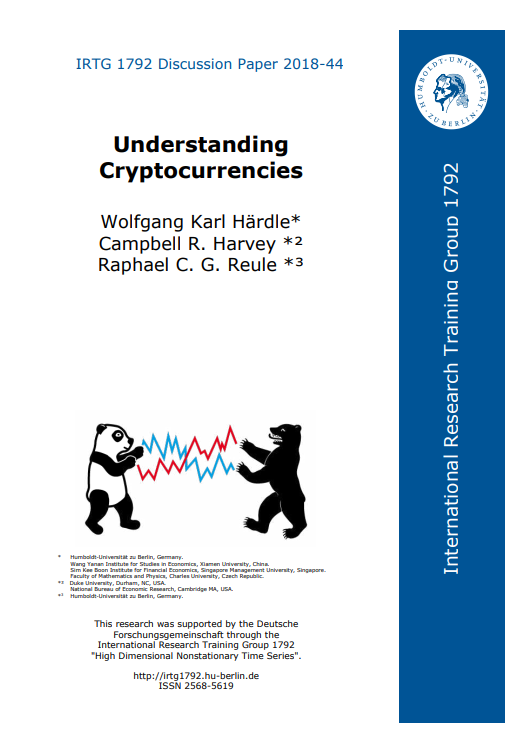
1 Introduction
In 2008, the pseudonymous “Satoshi Nakamoto” posted a white paper describing an
implementation of a digital currency called bitcoin that used blockchain technology. More
than ten years later, hundreds of cryptocurrencies and innumerable other applications of
blockchain technology are readily available.
The rise of cryptocurrencies poses an existential threat to many traditional functions
in finance. Cryptocurrencies embrace a peer-to-peer mechanism and effectively eliminate
the “middle man”, which could be a financial institution. For example, no bank account or
credit card is needed to transact in the world of cryptocurrencies. Indeed, a cryptocurrency
“wallet” serves the same function as a bank vault. With a smart phone and the internet,
the potential exists for a revolution in financial inclusion — given that over two billion
people are unbanked (GlobalFindex, 2017; World Bank, 2017).
The technology, however, goes well beyond providing banking services to the unbanked.
It holds the potential for cheap, secure, and near-instant transactions, allowing billions
of people to join the world of internet commerce, paying, and being paid, for goods or
services, outside of the traditional banking and credit card infrastructure.
Cryptocurrencies transactions potentially enable near real-time micropayments. Credit
cards are not designed to be used for a one-cent charge to download, for example, a
product or service from the internet. Cryptocurrency systems promise to make micropay-
ments seamless and allow businesses to offer real-time pay-per-use consumption of their
products, such as video, audio, cell phone service, utilities, and so forth.
A cryptocurrency like bitcoin can be thought of as a decentralized autonomous organi-
zation (DAO), an open-source peer-to-peer digital network that enforces the rules it is
set up with. In this DAO setting, the money supply is set by an algorithmic rule,
and the integrity of the network replaces the need to trust the integrity of human
participants. The growth of crypotcurrency technology therefore poses a challenge to
traditional monetary authorities and central banks, as Facebook’s “Libra” coin pre-
emission market acceptance suggests (Taskinsoy, 2019). Central banks understand this,
and many banks have initiated their own national cryptocurrency initiatives (Bech and
Garratt, 2017).
As with any new technology, risks are present. In the nascent cryptocurrency market,
one concern involves the anonymous nature of transactions in some cryptocurrencies,
which could allow nefarious actors to conduct illegal business, or worse, to pose a broader
threat to our society and institutions (Foley et al., 2018). The benefits, such as low
transaction cost, security and the promise of quick processing, are readily measurable,
but quantifying the risks is less straightforward.
In our view, any new technology involves risks; if we require no risk, innovation
is constrained (Catalini and Gans, 2016). Cryptocurrencies have, in contrast to many
markets, a plethora of available and free data, ripe for empirical investigation. We are
just now seeing the genesis of academic research focusing on this emerging technology
(Harvey, 2014, 2017a, 2017b; H¨ardle et al., 2018; Kim et al., 2019).
We have four goals in this paper. First, we explain the mechanics of cryptocurrencies
at a high level. Second, we detail useful data sources for researchers. Third, we provide
basic summary statistics given the available data. Finally, we offer a list of possible
research applications.
2 Cryptocurrencies and Blockchains
The concept of supplementary (Delmolino et al., 2016), alternative (Ametrano, 2016), or
digital currencies (Chaum, 1983) is not new, but the concept of an open-source currency
without a central point of trust, such as a central distribution agency or state lead control,
is new (King and Nadal, 2012). A cryptocurrency is a digital asset designed to work as a
medium of exchange using cryptography to secure transactions, to control the creation of
additional value units, and to verify the transfer of assets. Many different cryptocurrencies
exist, each with their own set of rules, see, for example, coinmarketcap.com (Iwamura
et al., 2014; Abraham et al., 2016; Bartos, 2015; Park et al., 2015). Differences among
the cryptocurrencies may involve, for example, the choice of the consensus mechanism,
the latency, or the cryptographic hashing algorithms.
2.1 High-level description of blockchain
Abadi and Brunnermeier (2018) describe a blockchain trilemma, i.e. that no ledger can
satisfy all ideal qualities of any recordkeeping system — correctness, decentralization,
and cost efficiency — simultaneously. Yet, a blockchain is more efficient than a centrally
managed traditional ledger (Babich and Hilary, 2018a). A blockchain can be implemented
in many ways, but most share several common features. We can think of a blockchain as
a very special database. A blockchain’s structure is shared, or distributed, rather than
centralized, and thus is often referred to as distributed ledger technology (DLT). Figure 1
shows a distributed network. As we discuss later, the distributed network provides some
level of security, because it is unlikely an attack can be launched on every copy of the
Understanding Cryptocurrencies Author Wolfgang Karl Hardle Campbell R. Harvey Raphael C. G. Reul




